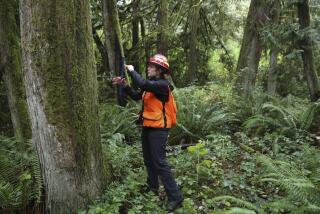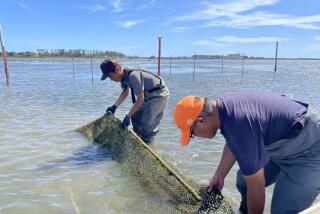Japan Sowed Seeds of Its Pollen Problem
- Share via
TOKYO — What on earth is ailing the weeping, sniffling, miserable Japanese seen on every street corner these days?
Not the nation’s worsening recession, its political dithering, the Asian economic crisis or even the Hong Kong avian flu. No, chances are the culprit is Cryptomeria japonica, a.k.a. the Japanese cedar tree, once one of the nation’s most beloved species and now the reviled producer of the pollen that has unleashed a dreadful allergy on one in five urbanites here.
Japan’s ill-fated love affair with the cedar is a classic tale of the unintended consequences of a seemingly benign environmental policy.
For centuries, shoguns and peasants have had a special affection for the cedar, known here as sugi. Besides its tall, noble good looks, the sugi is also extremely fast-growing, hardy and perfect for home-building.
After World War II, in an attempt to replenish forests that had been felled for firewood or scorched by bombs, the government offered generous subsidies for tree planting. Between 1955 and 1972, in national forests and on private land alike, Japanese eager for greenery and timber opted, en masse, to plant about 600 million acres of sugi and its almost equally allergenic cousin, the hinoki Japanese cypress. Now experts say at least 10% of Japan’s landmass is covered with the two species.
Although sugi trees have been growing in Japan for thousands of years, the related allergy was not identified until 1964, according to Dr. Sakae Inouye, one of Japan’s leading experts on the cedar problem. Because it takes 30 years for a sugi tree to mature and begin throwing off its pollen, it was not until the 1980s that Japan began to realize the magnitude of this arboreal gaffe.
Since then, things have only gotten worse. A recent survey by the Tokyo metropolitan government found that 19.4% of residents suffer some degree of cedar allergy, up from just 7% in 1983.
*
This spring, Koji Murayama, the chief pollen forecaster at the Japan Weather Assn., announced that global warming will almost certainly increase the pollen count because warmer weather in July prompts sugi to release more pollen the following spring.
Murayama based his calculations on two assumptions. First, he estimated that the average temperature will increase by 1 to 2 degrees centigrade by 2050. Second, he calculated that 40% more cedar trees will reach maturity over the next 50 years because sugi trees are still being planted, albeit in smaller numbers.
Based on those assumptions, Murayama forecasts an 80% increase in the number of allergy patients by 2050. If he is correct, that would mean one in every three Japanese citizens would be affected for up to four months of the year.
Already, the afflicted, who sometimes develop insomnia and rashes as well as the usual hay- fever symptoms, spend at least $40 million a year on remedies and medical treatment, according to the Japan Allergy Assn.
Murayama, himself an allergy sufferer, said it is possible to fight sugi allergies. He suggests taking note of pollen forecasts to prevent unnecessary exposure; using air cleaners indoors; and wearing an allergy mask, smooth clothing that pollen won’t stick to and a wide-brimmed hat to keep one’s hair from being contaminated while outdoors.
“Problem is, when you wear the goggles and the mask and a vinyl raincoat, you look like a bank robber, so I really can’t recommend this to people,” he said. Tokyo has a hotline that provides up-to-date information about which way the dreaded pollen--which can travel up to 60 miles--is blowing.
Cedar-bashers, calling themselves the Assn. of People Who Detest Cedar, have started their own Internet home page; they advocate cutting down some of the forests. And sufferers have their own parliamentary lobby, the Assn. of Sneezing Lawmakers, a group of 60 allergic politicians from the ruling Liberal Democratic Party, or LDP, that is pushing for more research into cedar pollenosis.
Alas, the sugi trees are likely to outlast even the perennial LDP. Cedars planted by the Tokugawa shoguns nearly 400 years ago at their burial place in Nikko are still going strong, and sugi trees in a forest on the island of Yakushima in Kagoshima prefecture are believed to be 2,500 years old.
Prospects for cutting down the newcomers are dim. Although the first postwar crop should be ready for harvest in about a decade, importing timber is so much cheaper than logging in Japan, primarily due to labor costs, that anyone who tried to fell and sell the sugi forests would probably go broke.
The Nature Conservation Society of Japan advocates gradually harvesting the cedars and replacing them with a diverse selection of native broadleaf trees--particularly in national forests, which the group believes should never have been logged and planted with sugi in the first place. But even environmentalists recognize that the current economics of timber mean that little can be done any time soon.
“It’s not realistic to cut the sugi down now, when you can’t make any money on them, because then there would be no money to invest in reforesting with broadleafs,” said Masahito Yoshida, director of the society’s conservation science division.
“The current situation, in which it’s cheaper to log in Southeast Asia and import trees than to cut the ones in our own backyard, is weird, no matter how much you believe in free trade,” Yoshida said. He believes that environmental concerns and shrinking world forests will eventually change the economics of the Japanese timber industry--but not for at least another decade.
*
Meanwhile, the allergy problem is growing so severe that the government has allocated $2.4 million for a three-year, multidisciplinary study. Research topics include developing better treatment methods, researching a vaccine, developing sugi breeds that give off little or no pollen and studying the still-unproven link between air pollution and allergies, said Hiroshi Nitta, an epidemiologist at the National Environmental Institute.
“It’s an extraordinary project given that this is not a fatal disease,” Nitta said.
Doctors say the increase in allergies among children has been particularly striking.
“We weren’t taught about allergies in medical school. We were told we didn’t have them in Japan,” said Inouye, 58, the author of a book on the sugi problem called “Allergies and Civilization.” Now 30% to 40% of Japanese children are believed to have some type of allergy, Inouye said.
The sharp increase in allergies among adults and children, which is common to most industrial countries, is believed to be the result of a combination of factors. They include particulate air pollution from diesel exhaust and other sources; an increase in the amount of pollen as more and more trees reach maturity; the advent of Western-style housing that traps pollen, dust and mold; and the changing Japanese diet and lifestyle.
Traditionally, Japanese babies were never fed red meat or eggs because such foods were rare and expensive. But there is growing evidence that the kind of protein an infant is first exposed to produces a kind of immunological “imprinting,” Inouye said, and that ingesting meat and eggs before the age of 1 may make children more vulnerable to allergies later. The Japanese diet featured more meat and eggs after the 1960s, according to the Tokyo survey, which also found that most Japanese allergy sufferers are under age 44.
Inouye’s group is also testing whether certain foods may help allergy sufferers. Tests of traditional Chinese herbal remedies for allergies have revealed that some are interferon inducers, which suppress the production of antibodies involved in allergic reactions, Inouye said. Now he is experimenting with feeding herbs to mice and studying their antibodies to see if there is an anti-allergy effect.
“It would be very cheap if you could use food as a medicine. . . ,” Inouye said.
For those who can’t wait for relief or can’t take anti-allergy medications, there are immunotherapy allergy shots that are effective for 70% to 80% of those who have cedar allergy, said Dr. Kimihiro Okubo, an allergist and assistant professor at Nippon Medical School in Tokyo. About 30% of patients become symptom-free after taking the shots, and 40% to 50% more report a decrease in symptoms.
But because the series of injections takes an entire year, only 10% of Japanese allergy sufferers opt for the treatment, Okubo said.
“The treatments are progressing, but the government must think seriously about what to do about this problem or there will be trouble,” said Okubo, who believes that it is possible that up to 50% of the Japanese population may develop allergies in the coming decades. “If it gets worse, no one will work in March, April or May. It will be a Japanese vacation.”
Chiaki Kitada in The Times’ Tokyo Bureau contributed to this report.
(BEGIN TEXT OF INFOBOX / INFOGRAPHIC)
Pollen Prediction
Pollen forecaster Koji Murayama has bad news for Japan’s allergy suffers: He says global warming will increase the amount of pollen that is released. Warmer weather in July will trigger greater releases of pollen from the sugi, the Japanese cedar tree, the following spring.
Percentage of increase in number of patients from 1990
* Source: Koji Murayama/Japan Weather Assn.






